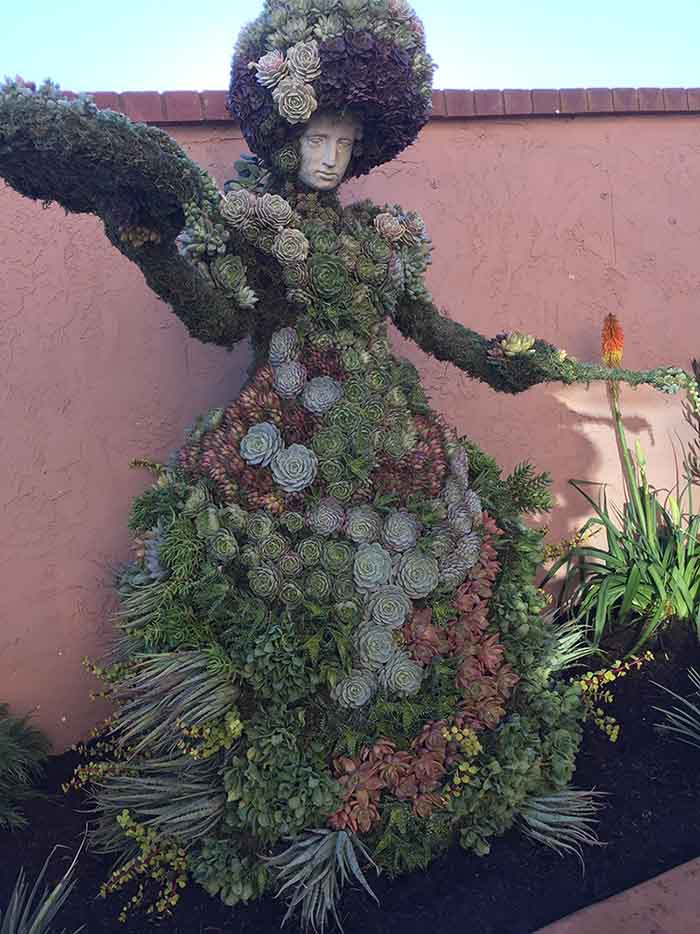How To Add Live Plants To Your Topiary Art Form
Use plants whose growth is spurred by trimming. This occurs with many different plants. This encourages the topiary to fill more quickly.
The better you are at designing and maintaining commercial topiary the more marketable you will be which in turn will encourage more customers to reach out and inquire about your services.
Let's dive into how to design and maintain commercial topiary. Whether it's for a client or simply for your own business, this is a great skill to have.
Plant Size Matters
If you use plants in containers, choose pots that most closely fit the size of the topiary form and the same shape when possible. Or, use a series of smaller pots in different areas of the inside of the frame. This allows your topiary to fill more quickly.
Small containers limit the size to which the plants can grow, so they may have to be replaced more quickly. But the limited growth will decrease how often you need to prune. Force plants into the right position, if necessary with packing peanuts or floral foam.
Use plants whose growth is spurred by trimming. This occurs with many different plants. This encourages the topiary to fill more quickly.
Scissors & Tools
Use scissors or a screw driver to poke or cut holes. Plant through the top of the mossed frame to fill bare spots. Let the moss dry to just a damp condition, not soaking wet. Sitting in soggy soil will kill most any plant.
Soak the moss in compost tea or other weak fertilizer to give your plants or cuttings a jump start.
These tools include:
• Hedge clippers
• Scissors
• Electric hand shears
• Pruning shears
Fertilizer Tips
Never use liquid fertilizer on plants in dry soil, always water first. You may also feed the topiary with a compost tea solution. Check fertilizer requirements for each plant you include in the frame.
Succulent plants only need fertilization once a year in spring, with a weak solution of 10-52-10, plant food that is high in phosphorous. This encourages a healthy root system to develop.
Traditional plant specimens need feeding more often, sometimes weekly or every other week. The 10-52-10 helps a healthy root system develop on all plants. The food also encourages blooms.
Once your root system is bigger and supporting plant growth, you can change to a balanced fertilizer, such as 20-20-20. This promotes healthy foliage growth.
Choosing Plants for Your Topiary Form
Choose just a few plants that have compatible water and lighting needs. Once you get them in place, you don’t want them to decline because they’re not getting enough sun or getting too much water. Remember, you can’t expect good results from a shade plant growing in full sun.
Many plants are somewhat flexible as to lighting requirements. When plants are established, with good roots and starting to show growth, a location with morning sun is best for them. Again, research your plants before using them in the topiary.
Low growing herbs are an option for areas where a trailing plant is needed. Herbs adapt to the space provided. Use herbs like creeping thyme with a low-spreading growth for those areas that don’t need taller plants.
Purchase inexpensive succulents to add through the top of the form. Let them callous on the ends before planting. If using this type of cuttings, plant them into dry soil within the form. Expect roots to develop within a month.
Other Plants to Consider to Add to a Topiary Form
If you are planting an animal form with a tail. Consider these interesting.
- 13) Sedum morganianum
- Burro’s Tail or Burrito
- Succulent
- Lime Green
- Zone 10
- Small leaves formed on a cascading stem can appear as a hanging tail
- Happily survives some neglect
- Morning Sun
- Sansevieria trifasciata
- Mother-in-law’s Tongue
- Snake Plant
- Low care, upright succulent
- Green with black markings
- Some types have a yellow edge
- Zone 10b-11
- Low light
- Use as Upright Tail

Copyright: TOPIARYTREE.NET